Atuona, Hiva Oa
After 27 days, 6 hours and 25 minutes at sea, we arrived in Atuona, Hiva Oa, the Marquesas, French Polynesia, on April 23, 2018. This is the island furthest northeast, and thus the closest to the Americas, of all islands in French Polynesia. French Polynesia is actually made up of five separate groups of islands, called archipelagos, each with their own geological history. All of the archipelagoes sprang from the bottom of the ocean through volcanic activity, but the extent to which their volcanic peaks still exist, or, conversely, the extent to which a surrounding coral reef has built up around the volcano while the volcano itself has sunk back into the sea, is a question of the age of the archipelago. The Marquesas are the youngest of the archipelagoes and therefore have the most rugged, jagged volcanic peaks that have not been worn away or sunk by time, and have the fewest if any coral reefs surrounding the islands. These islands are some of the most remote on earth. They are dramatic, savage, wet, jungle-covered volcanic craters, peaks and valleys, mostly uninhabited, with a wealth of fertile soil around their edges and in their interior valleys that provide the fruit basket for all of French Polynesia and beyond.
The island of Hiva Oa stretches approximately 15 miles in a westerly direction, and the entrance to Atuona is a large open bay about halfway along the southern coast. It was very frustrating not to be able to step onto land as soon as we approached it, but rather, we had to sail another two hours or so along its coast before we could find safe harbor. But what else would you expect, since those windswept jagged cliffs on the eastern side of the island were the first encounter with land seen by all that wind blowing across 3,000 miles of ocean? Of course they were harsh and foreboding! You would be too, if you had to tough out all that weather year around.
The anchorage is a small, protected bay tucked into the NE corner of the larger open bay, with a dock for large supply ships. It is made stunning by the imposing volcanic peak off in the distance above it, always shrouded in clouds. That peak begged Rick to go climb its ridge, but we thought better of that before finding ourselves up to our eyeballs in deep jungle growth and mosquitos. Besides, hiking boots don’t fit on the boat. The anchorage was crowded the day we arrived because the Aranui, part cruise ship and part supply ship, was at port, forcing all the anchored boats into only half of the small bay. We had to bow and stern anchor without being pushed by the current into another boat while we were doing it – not the conditions you want when you are sleep deprived and more anxious than you can imagine to just get your head on a pillow without being tossed around, and sleep together for the first time in a month.
Atuona is the largest town in the Southwest group of Marquesan islands, but the Lonely Planet guidebook refers to it as a “village.” The town’s whole circumference can be walked in about 15 minutes. But it is a half hour walk from the anchorage to town, so we were grateful for the little store attached to the gas station at the dock that sold fresh baguettes, ice cream bars, boxed fruit juice and other fun treats we hadn’t had during our long journey. Even getting onto the dock was tricky, though. At the end of the stationary wooden dock for the supply ships was a floating LEGO set of little square pontoons all attached together but moving independently. They were connected to the stationary dock by a wide wooden slab with 2×2 strips of wood for stairs. The pontoons rose and sank with the considerable tide; the dock remained stationary. See the video below for the excitement faced by a dinghy landing at Atuona!
Our first order of business was to check into the country. Otherwise, we were told, we would be illegal and could be fined or kicked out for failing to check in promptly, with nowhere else to go for hundreds of miles. So, after a good night’s sleep, the agent we had paid to help us took us to The Gendarmarie, Police Station, to check in. When we arrived, the doors were locked and no one was inside. After a few phone calls, our agent surmised that the officers had gone out on a call and no one knew if or when they would be back. That encounter set the tone for the rest of our official dealings: the formal rules did not jibe with reality. We decided that if they could blow us off, we could blow them off too. Instead of checking in the next day, we accepted an invitation from our friends on Muskoka to take an island tour on a pickup truck that had a bed with bench seats and shade.
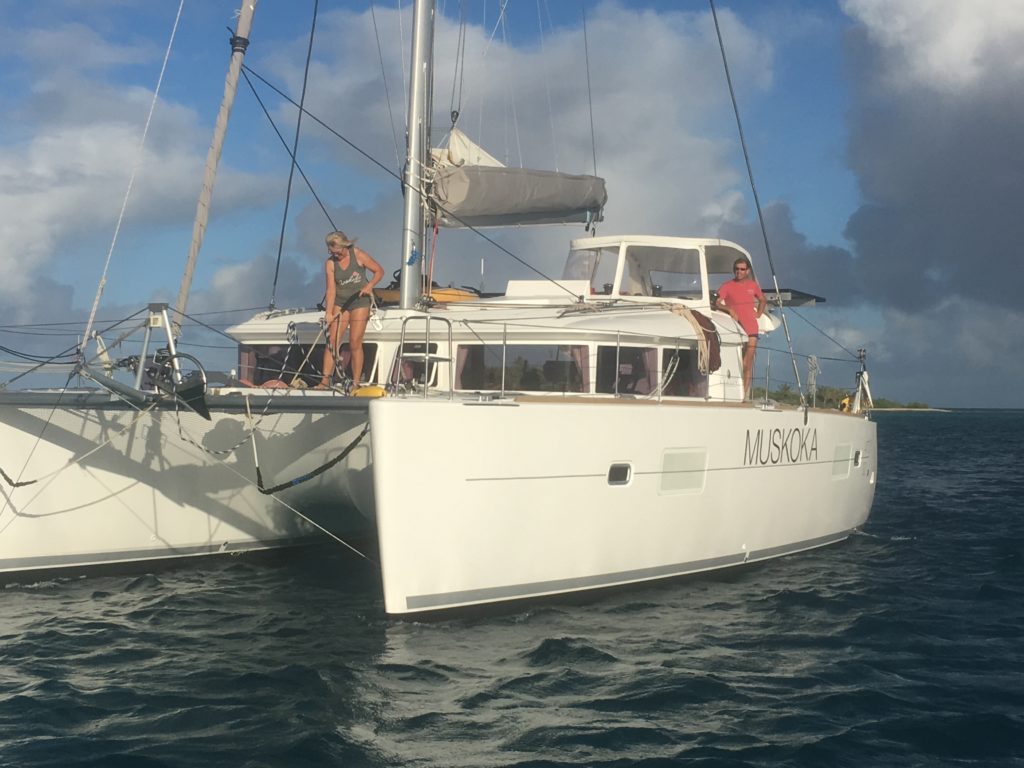
Scott and Laurie on Muskoka. We first met them at Paradise Village in Nuevo Vallarta. They have a much bigger and faster boat than we do, and have always been extremely generous and considerate with us. They are also great social activity planners. They invited us with them on a tour of Hiva Oa.
Our tour of Hiva Oa gave us our first glance of the interior of a Marquesan island. It is very rural, with steep volcanic peaks interrupting most attempts at paved roadways. Our tour took the best roads on the island, and even those were often gravel. As would be expected, the east to southeast sides were windswept and the interior and north side was dense jungle. Waterfalls abound. Small bays with white sand beaches were scattered all along the coast, many with a small village of a few houses, each inhabited usually by just one extended family.
During the tour, we stopped at the side of the road and took a small hike through the jungle to the tiki of a smiling girl, the only known tiki in French Polynesia that is smiling! We also stopped at a farm producing dried bananas and pamplemousse (large, sweet grapefruit that is ubiquitous in the Marquesas), at a pre-European archeological site, and at a seaside beach spot for a lunch our driver brought of Poisson Cru (like ceviche but with coconut milk) and other local foods.

We went for a hike to see this Smiling Tiki, the only one known throughout the islands to be smiling
Once back in Atuona, we finally found the Gendarmarie doors open and were able to check into the country legally. We also promptly addressed our next priority: getting traditional Marquesan tattoos that included a turtle to symbolize our having transitioned to Shellback status for having crossed the equator at sea.
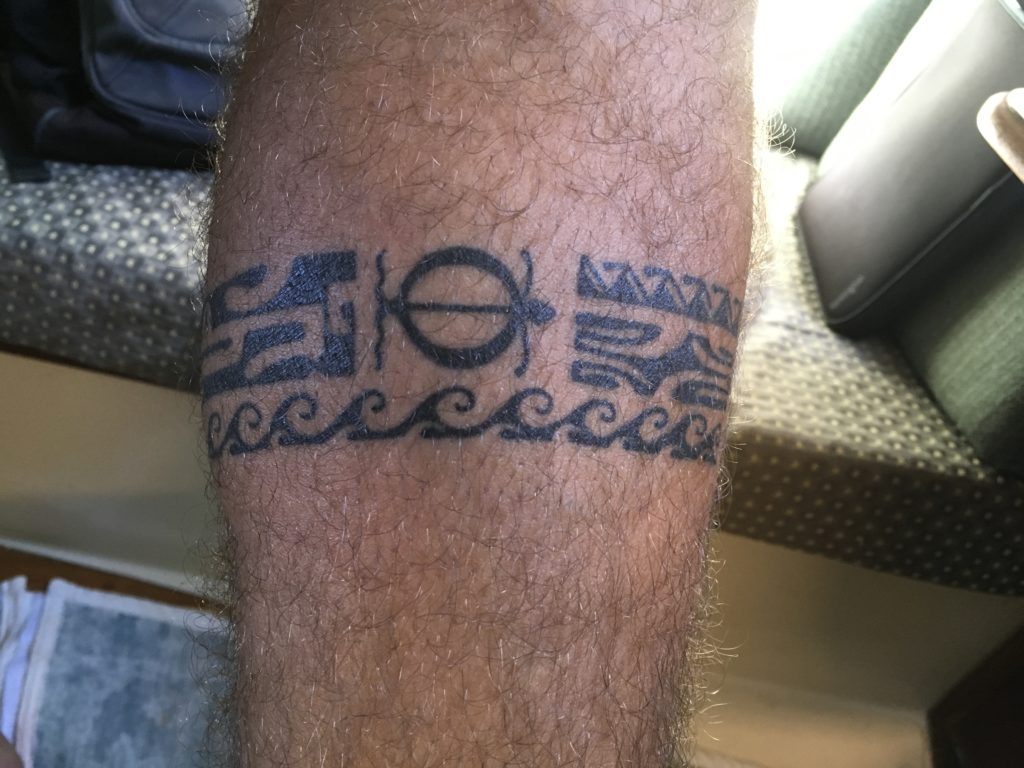
Rick has a band tattooed all the way around his left calf. This part shows the turtle, the waves and the Marquesan Cross.
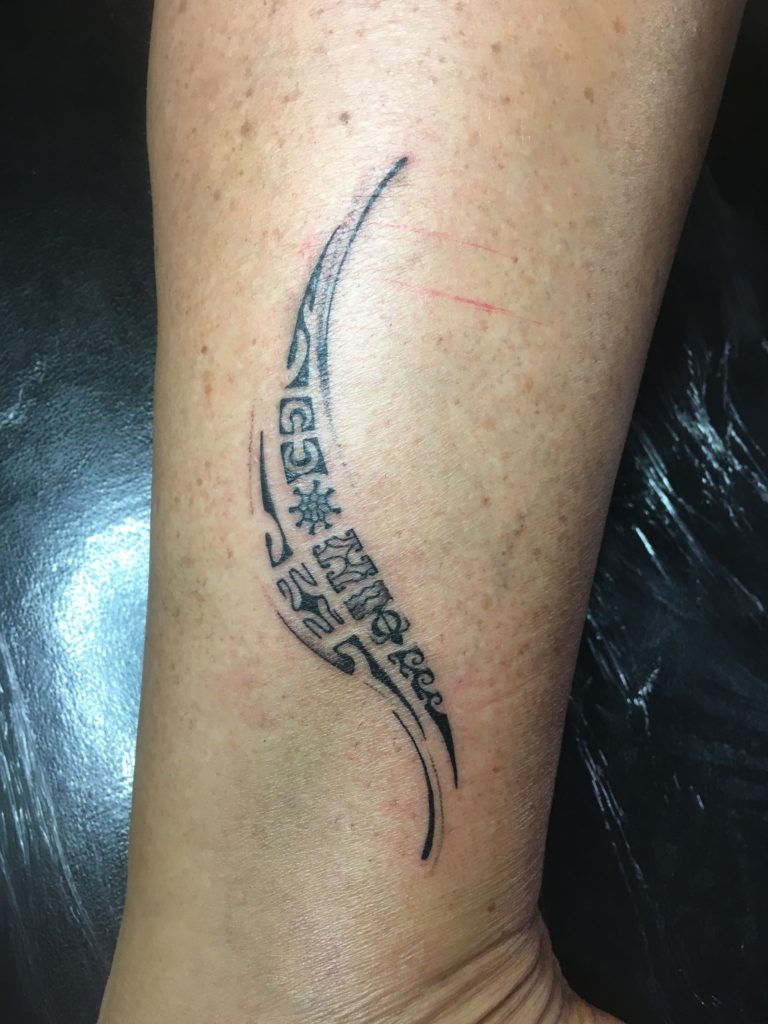
Cindy’s Marquesan tattoo, on her lower right leg. Included are the traditional symbols of spirit (power, “the force”), union of marriage, the sea, the Shellback turtle for having crossed the equator, a compass, and the Marquesan cross
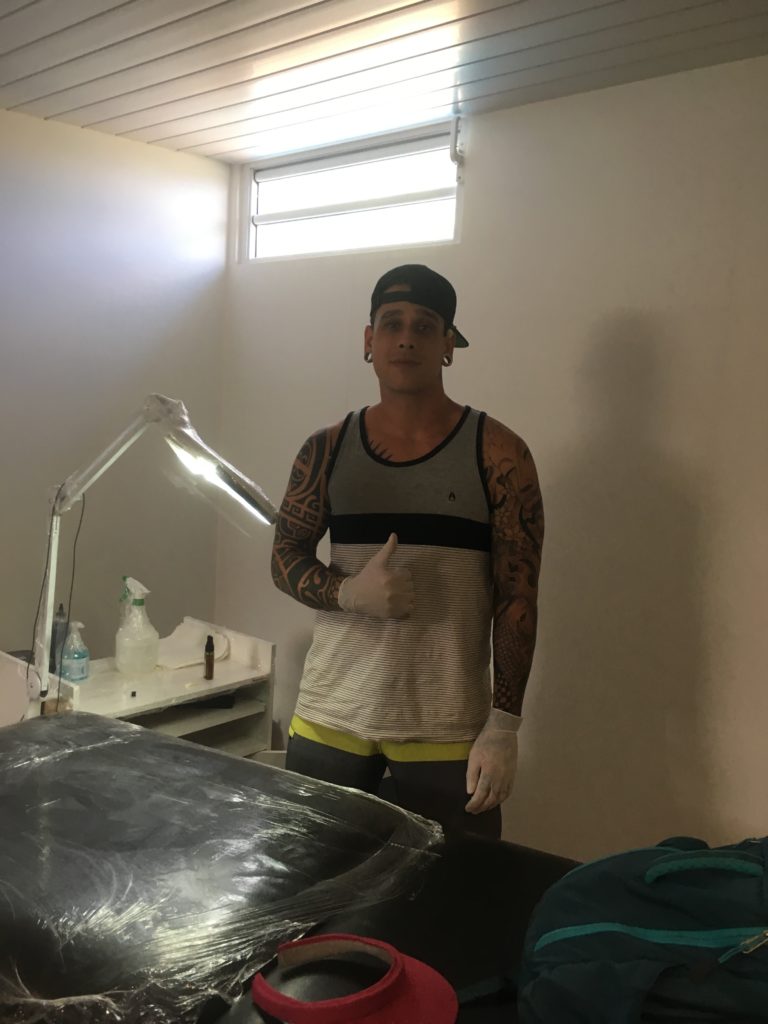
Our tattoo artist in Hiva Oa. Somehow having a good looking young man etch into my skin took a little bit of the edge off, but it still felt like a razor blade being repeatedly cut into me in the same place. If I had known how much it would hurt, I might have thought twice about getting one
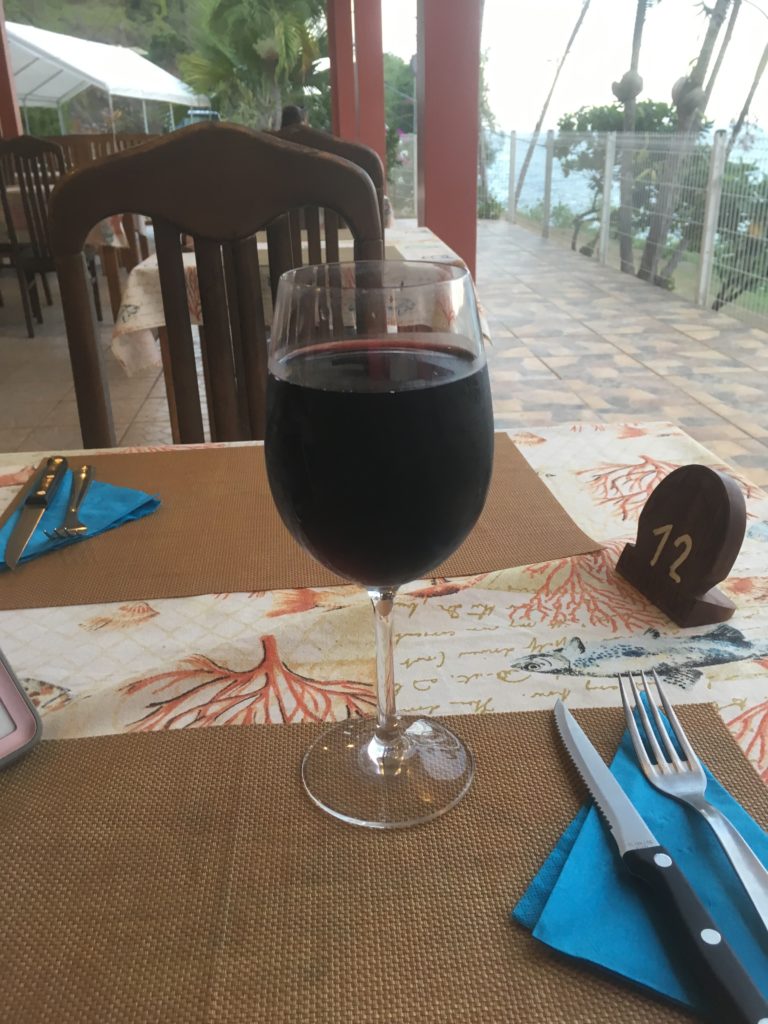
Cindy’s first glass of French wine in French Polynesia, at a pizza cafe overlooking the bay at Hiva Oa while waiting for Rick’s tattoo to be finished. I needed that glass after the painful tattooing experience. The glass wasn’t cheap, but it was a healthy pour, no?
Other Islands and Anchorages in the Marquesas
Less than 10,000 people total live on the six inhabited islands of the Marquesas. In all, we visited ten anchorages on four Marquesan islands: Hiva Oa, Fatu Hiva, Ua Huka and Nuku Hiva. Each had their own character and surprises. Overall, we found that the people live simply but abundantly. Nearly every family housing complex is set in a garden orchard of all the fruits and vegetables anyone could possibly hope for. They make their own coconut milk from the coconuts in their own yard, their own mango juice from their own mango trees, and their own green papaya salad from their own papaya plants. Everyone is a gardener and a farmer; you have to be, because buying any of these things in the store costs far more than growing your own. Wild fruit is so available that the walk into town at Atuona could supply enough mangos for weeks. For animal protein, you go on hunting trips into the interior of the islands where wild, free range cows, goats and boars are there for the taking, if you have a well trained dog and the agility and equipment to hunt and kill without a gun (bullets are hard to come by). Or else you just slaughter one of your chickens. The few grocery stores are small and supply just the basics, like flour and canned butter brought in on the supply ships. And everyone has a freezer, because things have to be stored, sometimes for a long time.
French infrastructure support has enabled electricity, street lights, docks, shoreline retaining walls where needed, and paved roads with well planned drainage, at least through the principal villages, along with the iconic working telephone booth in every town. Even in the smallest of hamlets, cleanliness seems to be a priority, along with neatly manicured walkways and roads adorned with colorful flowers and shrubs.

Hanamoenoa Bay on the island of Tahuata was the first remote anchorage we located after leaving the check-in port of Atuona. This was our first real experience of South Pacific cruising at its best. The water was clear and warm and the beach was white sand, with only one family inhabiting The Valley beyond. Cool Change looks great, doesn’t she?
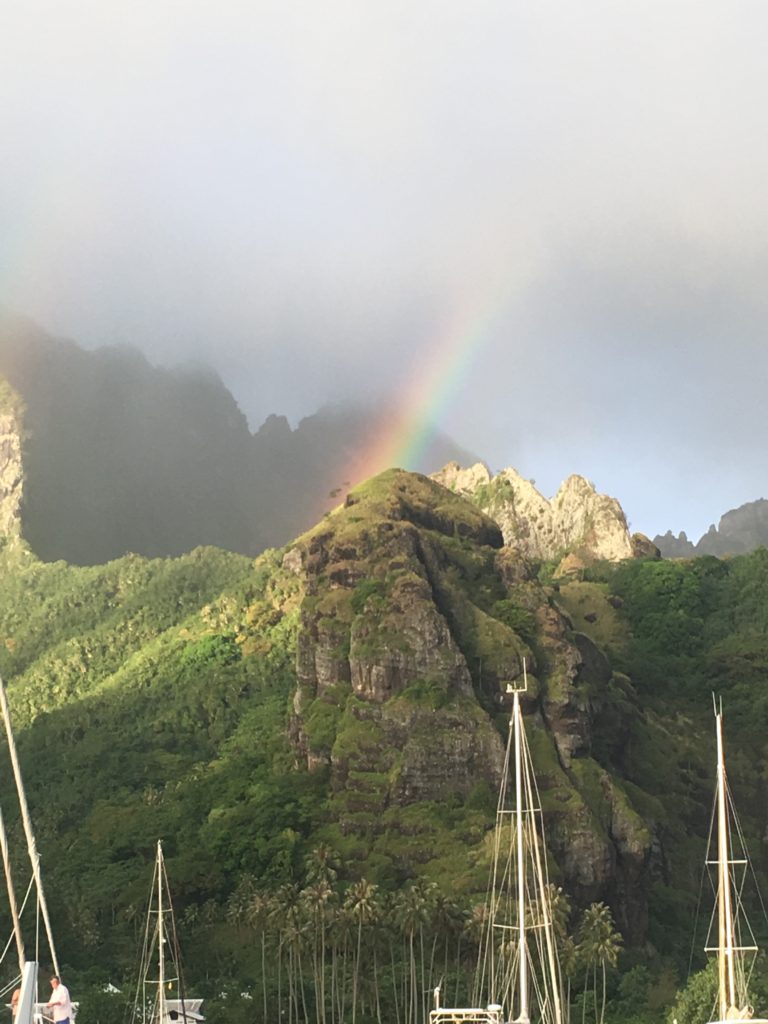
Fatu Hiva is a magical place. It is the most remote of the Marquesan Islands. I let out an audible gasp as we entered the anchorage, it was so stunning. The towering spires all around gave it the name, Bay of Penises (!) but the missionaries changed it to Bay of Virgins. Either way, the reference is sexual, which is appropriate for a place so incredible that the glorious feeling it imbues is almost sexual. We met a kind woman here who honored us as guests in her home for a traditional meal of chicken in a basil coconut sauce and green papaya salad, with skinned bananas on the side and pamplemousse for dessert. She didn’t request any money for her generosity.
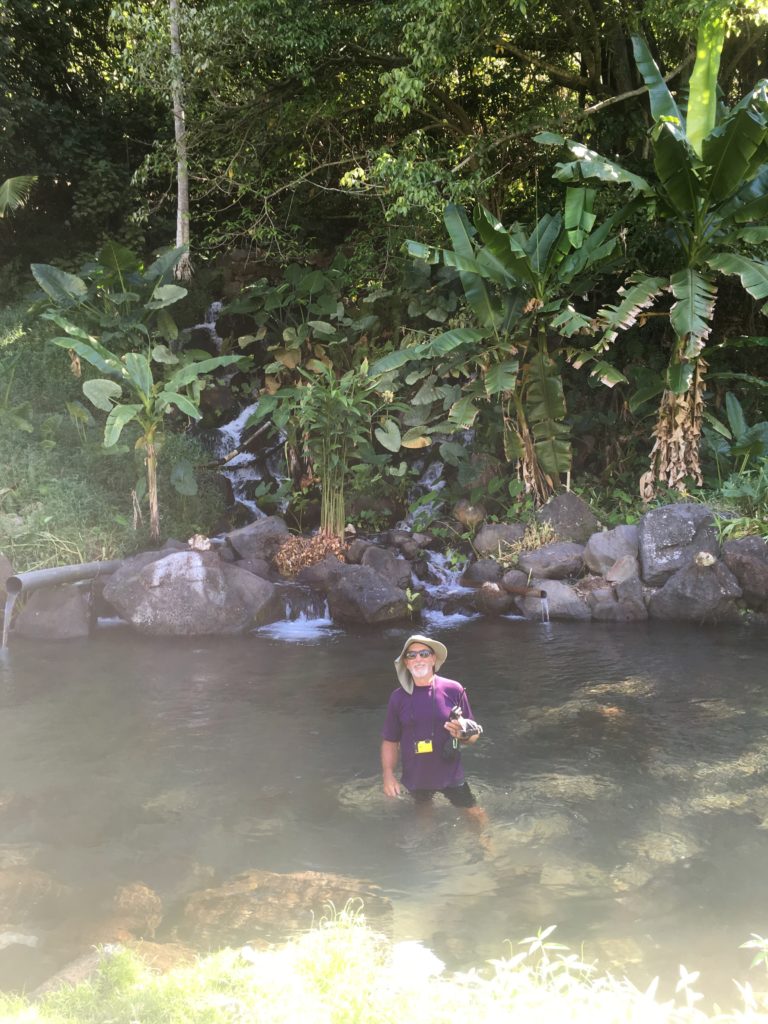
At Hanamenu Bay on Hiva Oa, we discovered a waterfall and natural fresh water pool just a moment’s walk up from the beach. It looked like only one family inhabited that valley.

Kua and Teiki at Hanatea Bay on Nuku Hiva. His necklace is made up of boar tusks that he salvaged from the wild boars he has killed for food in the valley up from their home. Kua made us a wonderful meal and told us about her ancestors who included the man who had been king of their valley before the Europeans arrived.

Kua and Teiki’s valley made us feel like we were walking through the Garden of Eden, minus the snake and apple. Rick couldn’t stop taking pictures. An extended family of twelve, with several living units scattered throughout The Valley, maintained the extensive coconut grove, fruit trees and colorful plants. They even had their own little church.
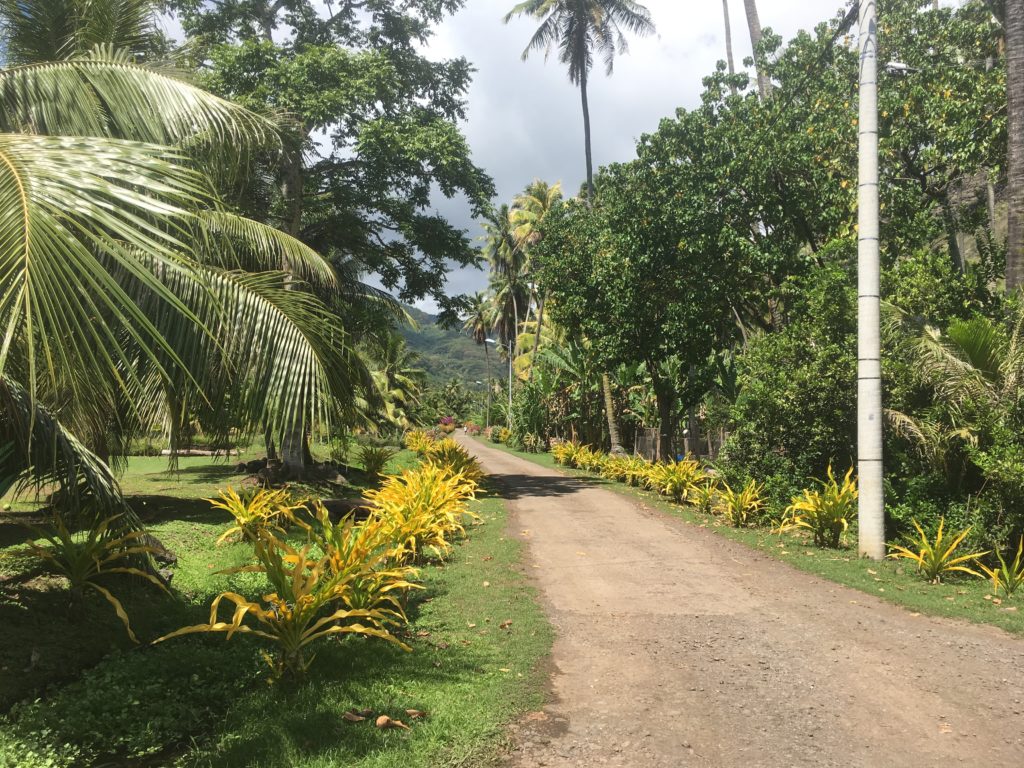
We came upon this road off the beach in a remote anchorage on Hiva Oa called Hanaiana. It leads to a fairly large village as island villages go, but it is still several hours by dirt road away from the main town on the island. Nevertheless, the road is adorned with neatly trimmed flowers and shrubs as though it were in a much more populated area. Polynesians seem to take such pride in making their natural surroundings so beautiful.

Laurie and Lisa, cruiser friends, pose in front of the telephone booth of Atuona. Every town has one. Atuona is bigger so it gets two.
As to other aspects of the culture, well, we can really only guess because our limited knowledge of French, let alone Marquesan, keeps us excluded from more nuanced aspects of life in the Marquesas. Crime seems to be minimal, especially in the smaller villages where everyone is related or at least knows each other. Our friend Kua from Hanatea Bay on Nuku Hiva said that the biggest danger you face in her valley is from a falling coconut! It seems that cars and scooters are available where there are roads to drive them on, although you have to pay a high price for having them shipped by supply boat from Tahiti. But we saw enough horses being ridden down the road as well as grazing in fields to believe that horses are still a common mode of transportation, especially where there are no paved roads. Most people are Catholic; the Catholic missionaries made a huge impression as some of the first European settlers on the islands, convincing the “pagans” that their religion was stronger because the indigenous people were dying off (due to foreign borne diseases) while the white men survived. As in Mexico, the missionaries tore down the old temples and built their churches on top of ruins.
Music, drumming, dancing and singing in harmony seem to be a huge part of the culture. In a pizza restaurant at our first landfall in Hiva Oa, a group of women held hands and sang a lengthy grace in harmony before eating! People can be found sitting around in groups making music almost everywhere you go. The church ceremonies are filled with singing, and again, it is all in harmony.
There is also an undercurrent of nothing more than tolerance for the French influence, and a resurgent pride in being Marquesan. Since 1984, when the islands of French Polynesia were issued some greater level of independence from France that is known as “Autonomy,” while still being under French rule, the indigineous language has been taught in school. All the people native to the Marquesas seem to know Marquesan and speak to each other in Marquesan when having a private conversation. They all know French as well, of course, as it is the official language of French Polynesia and the language used in public interactions. Many also know Tahitian, a completely different language from Marquesan, as well as English.
Traditional Marquesan tattoos are apparently known the world over, but here they are ubiquitous. Both men and women have them, and really, almost everyone has some. Shoulders and arms are popular for men, and legs for women. The Marquesan tattoo is a centuries’ long tradition here, and the same designs used back then are still propagated today. They have deep spiritual connotations and are designed to protect, embolden, or inform. The designs are somehow more regal than the Mamma’s Boy tattoos of old in the States, when only bikers, hookers and ex-cons adorned themselves with them. I must admit, when tattoos started becoming chic in the U.S., I had a hard time shaking the low-class stigma of tattoos born from my upbringing, but when I see some of these tall, golden-skinned, dark haired, well built men covered in Marquesan tattoos, I gotta admit, it is sexy. Very sexy. Rick’s leg band is sexy. I am a convert.
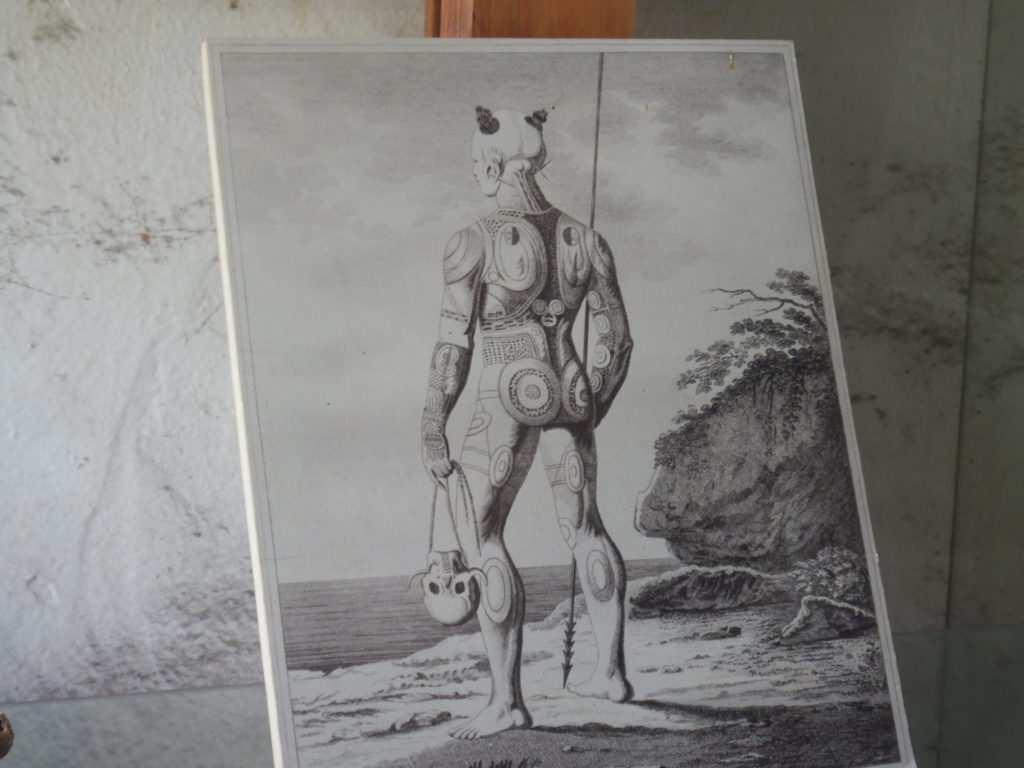
A drawing from a museum dedicated to the Marquesan traditions. Here is an example of the kinds of tattoos placed on men’s bodies as a sign of accomplishments and stature in the community, in the times before the influence of the Europeans, who banned tattoos centuries ago. Obviously, the tradition has since been revived.
Besides tattoos, other art forms specific to the Marquesas are wood carvings, cow bone carvings, and drawings made on special paper made from the bark of local trees (called tapas). There is really not much industry in the Marquesas except for fishing and the export of fruits and dried coconut shells (called copra), so many villagers have taken to making and selling art to the few visitors who pass through, and via the art contests that occur in Tahiti every year. A tradition we liked a lot in the Marquesas was that every time you bought anything from an artist, they also gave you some free fruit to take home with you. We thought it was a good sales practice too – the fruit was offered usually before the sale was made, so we felt we SHOULD buy something after we got the fruit for free. A British group came through one village at about the same time as we did, and they were given bundles of fruit but didn’t buy anything. So I guess that strategy doesn’t work on everyone!
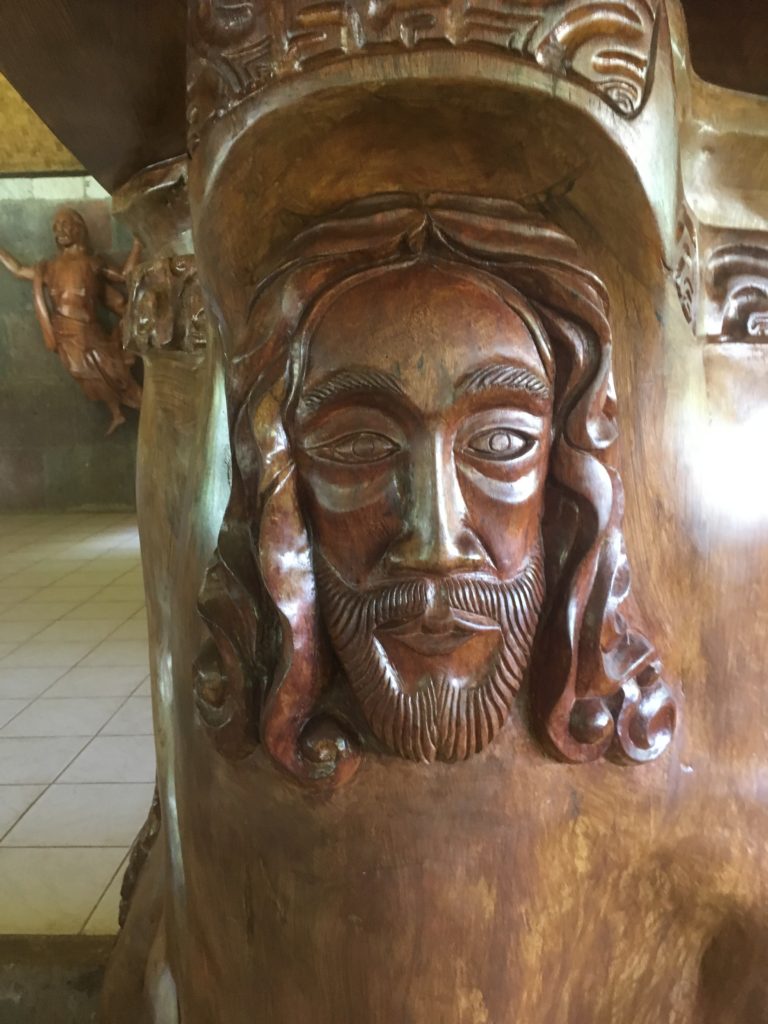
On our tour of Nuku Hiva, we met the man who built the local church’s pulpit and carved into it, this face of Jesus. We went to his workshop.
Some of our sailing friends found the Marquesas less interesting than their subsequent stops in The Tuamotu and the Society Islands archipelagoes, but Rick and I were both enchanted by the Marquesas. I guess you never forget the first place you land after crossing 3,000 miles of ocean; that must be part of it. But they were more exotic, more remote, more adventurous, in our opinions, than what has followed so far. Granted, snorkeling and swimming were really not that inviting there; they can’t compare to coral reefed atolls for water quality or visibility. But they have their own unique charm. We have fond memories of our visit there.
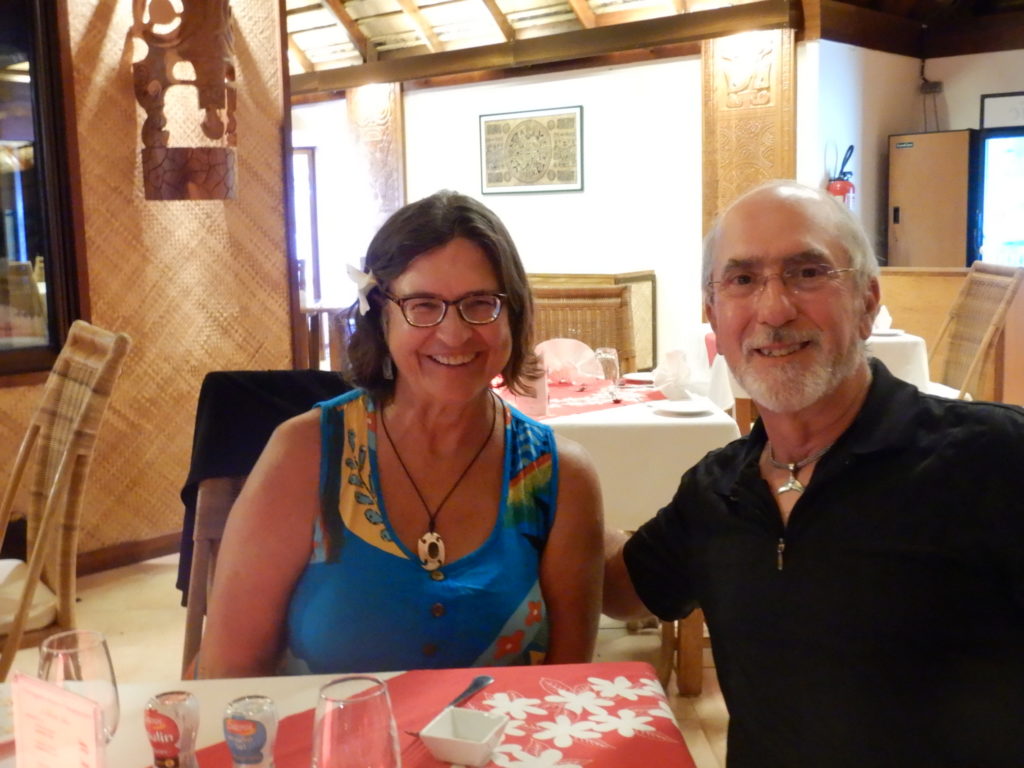
Not long before we left the other major population center of the Marquesas, Toaehae Bay in Nuku Hiva, we celebrated our wedding anniversary with a fine dinner out at the Pearl Lodge overlooking the bay
Sailing the Marquesas
Just a little note about sailing the Marquesas. The prevailing winds are E to SE, so we tried to plan most of our excursion through the Marquesas sailing north to northwest on a downwind point of sail. The exception was backtracking from Hiva Oa, where we had to go first to check into the country, and then SE to Fatu Hiva. We were expecting to bash our way to Fatu Hiva, but instead, we got lucky at first and had mostly a beam reach. Then the wind died and we motored the rest of the way with relatively calm seas.
Throughout our Marquesan sailing, the wind was mostly variable and inconsistent. Rarely were we able to sail the whole distance because the wind would die. Of course, it died only when we least needed it, like when we tried to head upwind on Nuku Hiva from Taoehae Bay heading east to Controllers bay and then to the NE side of the island to the anchorage everyone raves about up there. We had 9 to 12 foot seas and 25 to 30 knot winds on the nose and we making no headway; we turned around and went to Hanatea Bay instead, which turned out to be a real treat. Also, we learned to expect squalls. They come up at the most unanticipated times and can either be a menace or a blessing, depending on whether you enjoy a fresh rain shower and need some extra wind or not. And you are not immune from their effects even if you are in a “protected” anchorage – the wind from the squall can sweep up and over the mountainside into the valley, causing a funnel effect and concentrating the wind to increase its velocity.
All of the islands and anchorages in the Marquesas are only a day sail away from each other, making it fun to hop from one to another. However, as a slow boat, we had to leave before dawn to insure sufficient time to anchor before dark when sailing from Tahuata to Fatu Hiva, and from Hiva Oa to Ua Huka.
The currents and winds between islands close together can be a little strong, especially between Hiva Oa and Tahuata, but on light wind days, those currents and winds gave us a little boost we enjoyed.
Whenever the wind did something unexpected in the Marquesas, I just reminded myself that we were on little specks of land that represent the first obstruction for all that wind building up over 3,000 miles of open ocean to the east. That helped explain the strong wind patterns in a way I could understand, and made me feel grateful I was indeed anchored near dry land instead of still out in the middle of the ocean with no recourse but to shorten sail and hope for the best!


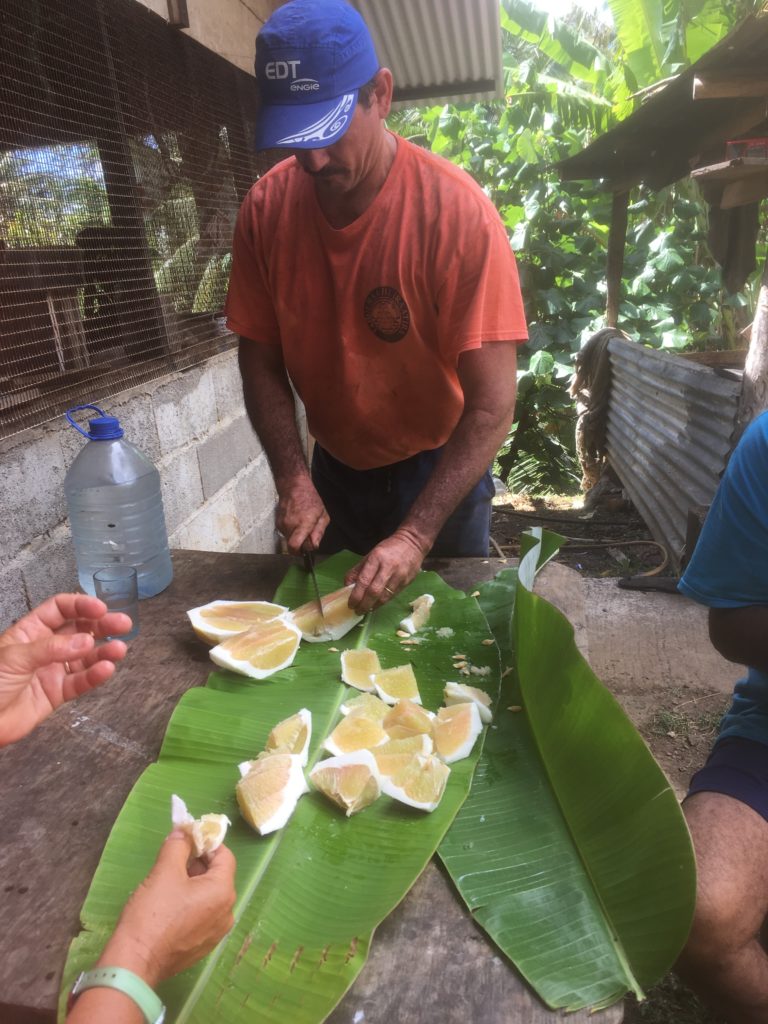
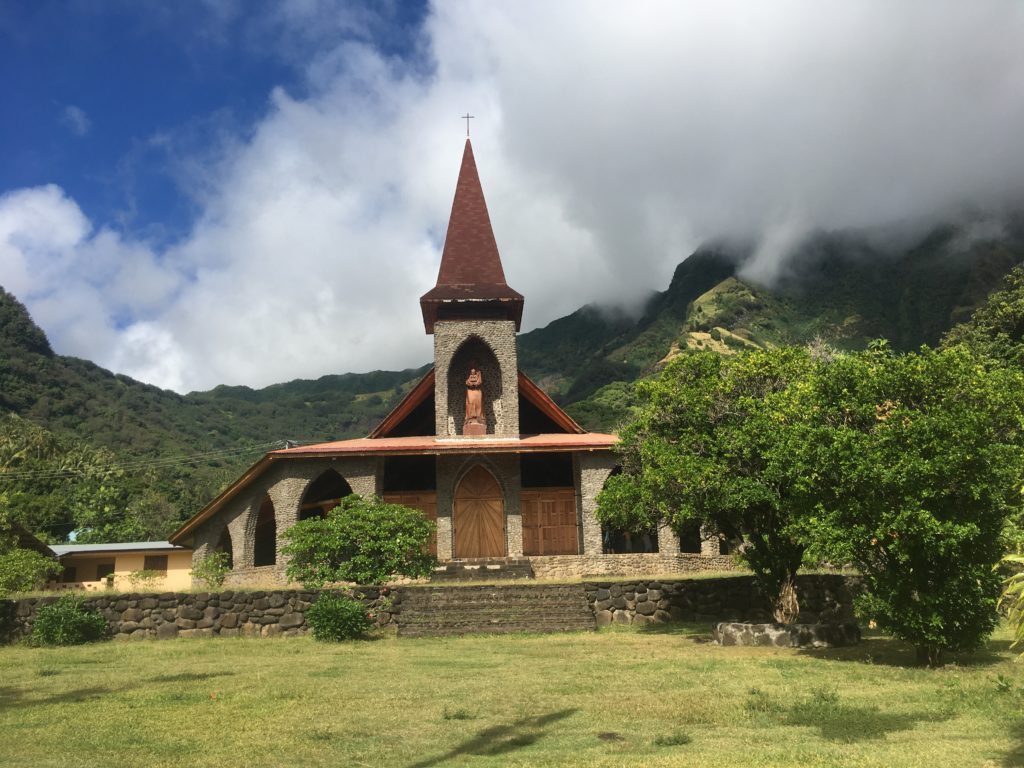


Love the Tats!!!! Congrats!!
Black on black in the Charger I’m creepin’ Rub me the right way, you might get a genie B.o.B, black Houdini
Thank you for sharing your trip experiences. Similar trip is on my bucket list. By the way your tattoos are very unique. Can you please let me know where this tattoo artist is or if you remember his name. Definitely want to visit his shop. I wonder how Rick’ s band tattoo looks like from the other side and what meaning it has.
Peter
Hi Peter. We got the tattoos in Atuona in Hiva Oa. I don’t remember his name but I think he is the only tattoo artist in Atuona. His shop has big letters that say “tattoo” and it is on the right side of the road up the hill as you enter town from the dock. I will try to dig up a picture of him and email it to you. There is a book all local artists have of the traditional Marquesas tattoos and their meaning – we chose our designs from those. His include a turtle (to symbolize our equator crossing), waves, compass, sting ray, a symbol to acknowledge his love for his sister who died, and other symbols. Thanks for asking.
Cindy,
Thanks for your response. I was in Tahiti, Moorea and Bora Bora in the past but did not get a chance to get tattoo there. Will certainly get one at the same place you did.
Peter